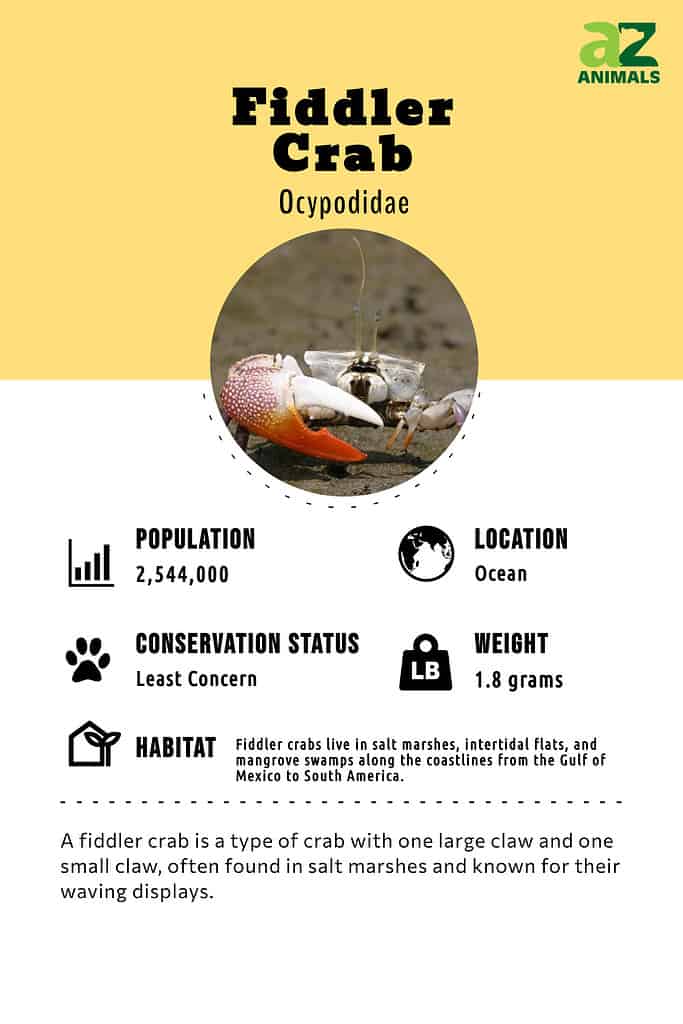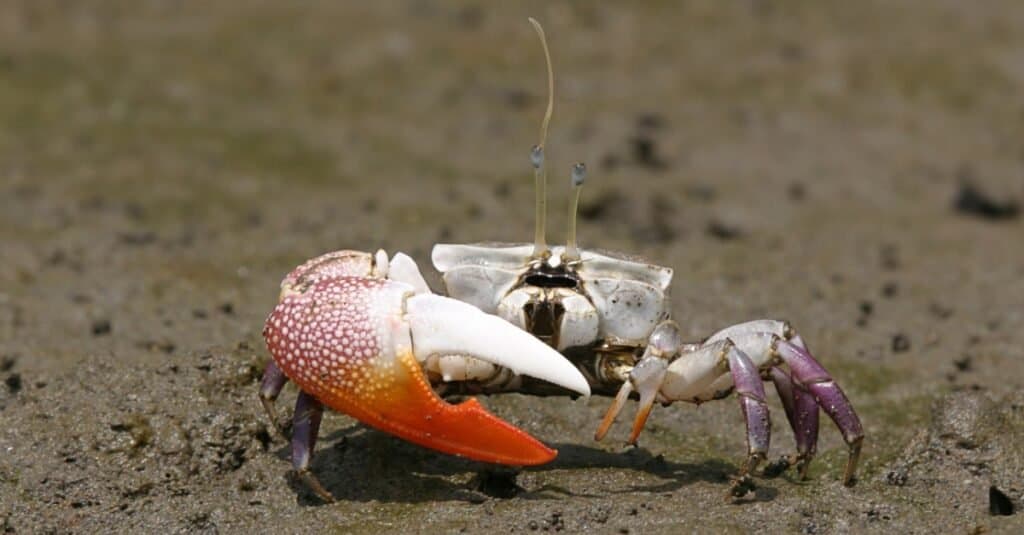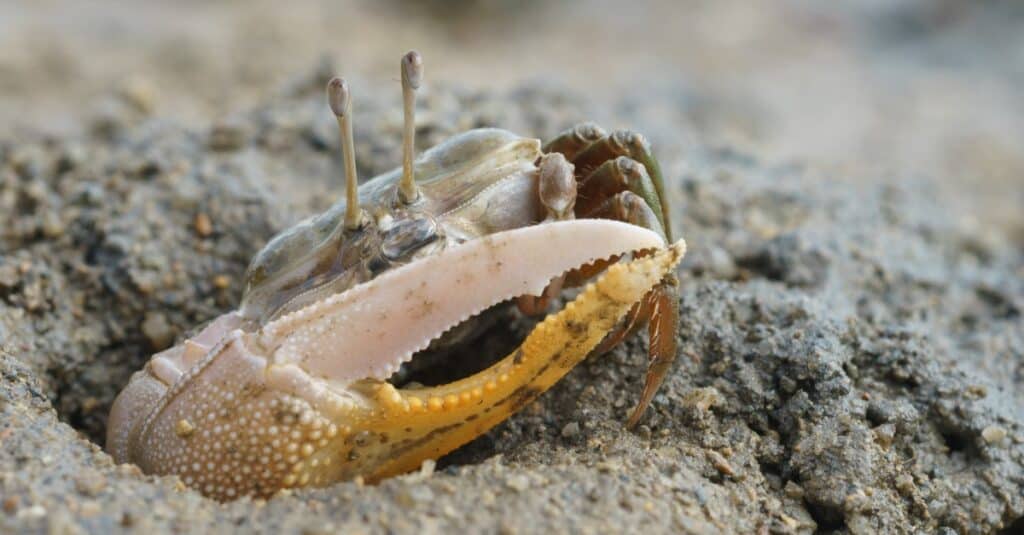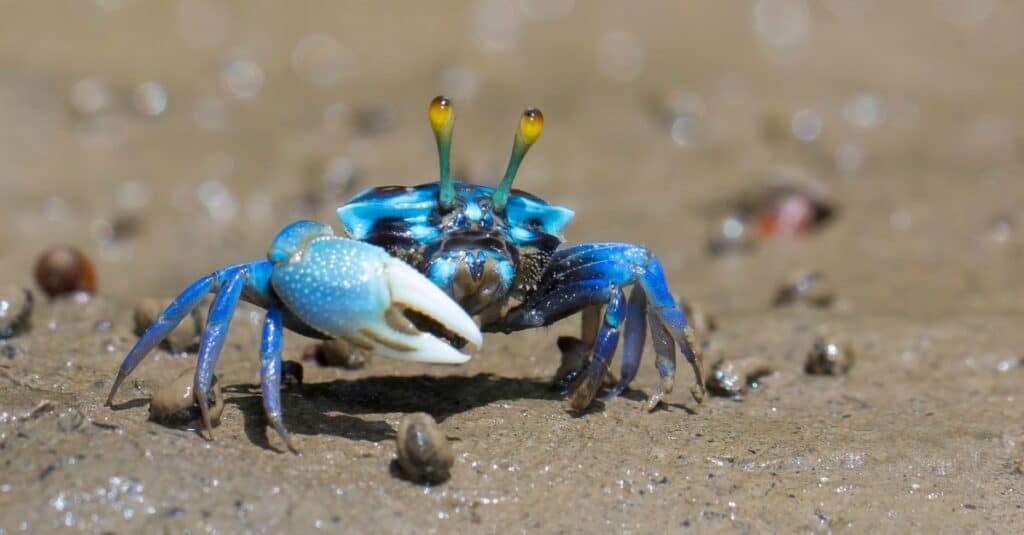Fiddler Crab
The fiddler crab gets its name from the motion the males make with their over-sized claw during the mating ritual.
Advertisement
Fiddler Crab Scientific Classification
Read our Complete Guide to Classification of Animals.
Fiddler Crab Conservation Status
Fiddler Crab Facts
- Prey
- Dead, decaying plants and animals, bacteria, algae, and fungus
- Group Behavior
- Colony
- Fun Fact
- The fiddler crab gets its name from the motion the males make with their over-sized claw during the mating ritual.
- Biggest Threat
- Habitat loss
- Most Distinctive Feature
- Enlarged claw on the male
- Gestation Period
- 2 weeks
- Optimum pH Level
- 7.2 to 8.2
- Habitat
- Sandy beaches and salt or brackish water
- Predators
- Egrets, herons, raccoons
- Diet
- Omnivore
- Type
- Crustacean
- Common Name
- Fiddler crab, Calling crab
- Number Of Species
- 106
View all of the Fiddler Crab images!

The fiddler crab is one of over 100 species of crabs that live on both land and sea. Most often found along intertidal areas of lagoons and mudflats, they can also be found on sandy beaches. While some tolerate saltwater, most prefer brackish water along the intercoastal areas.
4 Incredible Fiddler Crab Facts!

The male fiddler crab earns its name from the distinctive “fiddling” movement it performs in order to court a female partner.
©iStock.com/craykeeper
- The fiddler crab gets its name from the “fiddling” motion the male makes to attract a mate.
- Most species of fiddler crab have a 50-50 split on whether their right or left claw is enlarged. However, in one species, Uca vocans vomeris, the majority of the makes are right-claw dominant.
- The female chooses her mate based on the size of the enlarged claw as well as the way he performs with it.
- The fiddler crab can temporarily seal its burrow from high tides and predators, breathing air trapped in the burrow.
Different Types
- Atlantic sand fiddler
- Minuca minax
- Paraleptuca chlorophthalmus
- Paraleptuca crassipes
- Minuca pugnax
- Gelasimus vocans
- Leptuca coloradensis
- Leptuca helleri
- Minuca marguerita
- Uca mordax
- Gelasimus vomeris
- Minuca longisignalis
- Minuca rapax
- Paraleptuca splendida
- Paraleptuca boninensis
- Leptuca terpsichores
- Leptuca speciosa
- Leptuca panacea
- Minuca virens
- Minuca brevifrons
- Leptuca subcylindrica
- Leptuca stenodactylus
- Minuca burgersi
- Leptuca cumulanta
- Leptuca festae
- Leptuca saltitanta
- Leptuca deichmanni
- Minuca victoriana
- Leptuca limicola
- Minuca osa
- Minuca vocator
- Leptuca beebei
- Leptuca oerstedi
- Leptuca batuenta
- Minuca galapagensis
- Leptuca dorotheae
- Leptuca musica
- Minuca argillicola
- Minuca ecuadoriensis
- Leptuca spinicarpa
- Leptuca uruguayensis
- Leptuca crenulata
- Leptuca leptodactyla
- Leptuca thayeri
- Uca jocelynae
- Uca dampieri
- Uca borealis
- Uca lactea
- Austruca iranica
- Tubuca urvillei
- Uca monilifera
Classification and Scientific Name

Fiddler crabs have been classified into 106 different species.
©Dave Montreuil/Shutterstock.com
The fiddler crab is in the phylum Arthropoda, subphylum, Crustacea, class, Malacostraca, order, Decapoda, Infraorder, Brachyura, family, Ocypodidae, and genus Uca. There are 106 recognized species of fiddler crabs. Also known as calling crabs, they are most closely related to ghost crabs.
One of the adaptations that all fiddler crab species share is the enlarged claw of the male. While this claw is useful for attracting a mate, it makes him less efficient than the females when sifting through the sand for meals.
Evolution and Origins
Fiddler crabs are widespread, ranging from the Gulf of Mexico to South America, and are abundant in salt marshes, where they fulfill a significant ecological function.
Fiddler crabs, also known as calling crabs, are a group of around 65 species in the genus Uca belonging to the Decapoda order of Crustaceans, and they’re called “fiddler” due to the enlarged claw of males, resembling a violin, while females have relatively smaller claws.
Fiddler crabs have adapted well to life on land and display remarkable behavioral complexity for an invertebrate, with their mass-waving displays serving as a means of communication, and their specialized stalked eyes being well-suited for vision in a flat environment.
Species

Among the 106 identified species of fiddler crabs, some of the most prevalent ones include the freshwater fiddler, spined fiddler, and panacea sand fiddler.
©abcwildlife/Shutterstock.com
Of the 106 species of the fiddler crab, a few of the most common are the fresh-water fiddler, spined fiddler, and panacea sand fiddler. The fresh-water fiddler, also known as the red jointed fiddler’s range extends from Massachusetts to the central part of eastern Florida.
It also extends from the western central coast of Florida to Louisiana. Its body, or carapace, can reach 33 mm in width. It prefers freshwater marshes and areas of low salinity and is most commonly found near the mouths of rivers.
The spined-fiddler crab lives along the Gulf of Mexico, from Tabasco Mexico, into the United States, as far east as Alabama. Their carapace can reach a width of 23 mm. They prefer fresh to brackish water and prefer areas with clay, mud, or a mixture of clay and sand substrata. They are most commonly found in marshes and intertidal banks.
The Panacea sand fiddler lives along the Gulf of Mexico, from Panacea, in the Florida panhandle, to the Tabasco-Campeche border in Mexico. Their carapace can reach up to 18 mm in width. They are found in intertidal salt marshes and sand flats.
Appearance

The most distinctive feature of the fiddler crab is the extreme size difference between the two claws on the male.
The most distinctive feature of the fiddler crab is the extreme size difference between the two claws on the male. The male waves the enlarged claw back and forth rapidly when attempting to impress a female. The female selects her mate based on not only the size of the claw but also on his “fiddling” display.
The male of the species has a brighter body, or carapace, than the female. It is typically blue to purple-gray, with brown or black spots. The females have more subdued brown or black carapaces.
The crabs have a square-shaped body, a smooth carapace, and long, slender eye stalks. The different species of fiddler crabs range from one to two inches long.
Distribution, Population, and Habitat

Fiddler crabs can be found in numerous locations worldwide, including the eastern seaboard of North America, the Gulf of Mexico, and the western coast of the Pacific Ocean.
©aDam Wildlife/Shutterstock.com
The fiddler crab lives in many areas throughout the world. In North America, they live along the eastern seaboard (the western Atlantic), the Gulf of Mexico, and the west coast (eastern Pacific). They also live in the Indo-Pacific, parts of the Portugal coast, and West Africa.
Fiddler crabs live in areas with sandy or a combination of sand and clay soil. They cannot live in areas with dense clay soil, as they need to filter through the soil for food. Most prefer brackish water, which is a combination of fresh and saltwater, although some species do live in areas of pure salt or freshwater. They are most prevalent along intertidal areas in marshes and flats that provide protection and an abundant source of food.
Predators and Prey
Although raccoons will catch and eat fiddler crabs, the biggest threat to these animals comes from the sky. Egrets, herons, terns, and other waterfowl all consider the fiddler crab an excellent food source.
One of the adaptations the fiddler crab has is its ability to close off its burrow with a small scoop of mud or sand. This allows the crab to hide from predators until the threat passes. While fiddler crabs are generally territorial, when hiding from danger, they will take advantage of the nearest burrow.
Other animals do not need to worry about being eaten by the fiddler crab. Their diet is made up of bacteria, decaying plants, and algae. They use their claws and mouth to sift through the mud and sand for food.
Reproduction and Lifespan
In preparation for mating, the male fiddler crab builds a burrow. He then stands by the opening, waving his enlarged claw to attract attention from females. If the female shows interest, the male will run between her and the burrow several times until she follows him in or leaves the area.
After mating, the female remains in the burrow for two weeks, incubating eggs. At the end of this period, she leaves the burrow and releases the eggs into the water. There, they hatch and mature.
During the summer, the fiddler crabs mate every two weeks. The average lifespan of the fiddler crab is between 1 1/2 and 2 years.
Fiddler Crabs: Male vs Female
Only the male has an enlarged claw on one side. The male is also more brightly colored than the female.
Fishing and Cooking
While this crab is edible, it is so small, it doesn’t provide much meat. Preparing the crab for eating is more trouble than it is worth. They are a good bait choice when fishing for inshore fish, such as redfish and black drum.
View all 91 animals that start with FFiddler Crab FAQs (Frequently Asked Questions)
What is a fiddler crab?
The fiddler crab male uses its oversized claw to attract a mate. Fiddler crabs live on coastal flats and marshes. Most prefer brackish water.
What does a fiddler crab look like?
The crabs have a square-shaped body, a smooth carapace, and long, slender eye stalks. They range from one to two inches long. The male has one oversized claw and is more colorful than the female.
What does a fiddler crab eat?
Algae, bacteria, and decayed plant matter
Why do fiddler crabs have a big claw?
To attract a mate.
What do fiddler crabs get eaten by?
Waterfowl such as herons and small predators such as raccoons.
Are fiddler crabs aggressive?
Although they live together communally, they will defend their burrows.
Can you eat a fiddler crab?
You can, but their small size makes it impractical.
How many fiddler crabs can I put in a 10 gallon tank?
Four fiddler crabs can live comfortably in a 10-gallon aquarium.
Will fiddler crabs pinch you?
They can, and although a pinch shouldn’t be too painful, it is important to take care when handling them. Be gentle when picking them up and placing them in the aquarium, and don’t startle them when feeding or cleaning the tank.
How long can a fiddler crab stay underwater?
One of the adaptations that make the fiddler crab different than other crabs is that it is semi-aquatic. While it has gills, it needs to breathe oxygen. The gills need to be moist to work properly. While they can survive up to 2 days out of the water, they will not survive if left in a tank without access to dry ground.
Can fiddler crabs swim to the surface?
Yes, they are semi-aquatic, meaning they live on both water and land. When setting up an aquarium, it is important to have a sandy substrate built with an incline. This allows the crab to move in and out of the water on its own.
They also need some rocks in the tank, to provide hiding spots. Finally, you can care for a group of fiddler crabs, but there should be only one male in the group to prevent fighting.
Thank you for reading! Have some feedback for us? Contact the AZ Animals editorial team.
Sources
- University of Southern Mississippi, Available here: https://www.usm.edu/gulf-coast-research-laboratory/
- Fidler Crabs, Available here: https://www.fiddlercrab.info/
- Kiddle, Available here: https://kids.kiddle.co/Fiddler_crab

















